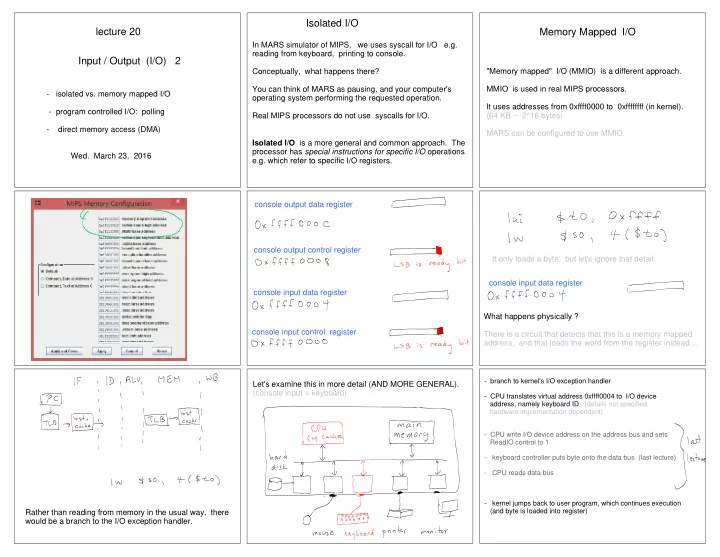

Isolated I/O lecture 20 Memory Mapped I/O In MARS simulator of MIPS, we uses syscall for I/O e.g. reading from keyboard, printing to console. Input / Output (I/O) 2 Conceptually, what happens there? "Memory mapped" I/O (MMIO) is a different approach. You can think of MARS as pausing, and your computer's MMIO is used in real MIPS processors. - isolated vs. memory mapped I/O operating system performing the requested operation. It uses addresses from 0xffff0000 to 0xffffffff (in kernel). - program controlled I/O: polling Real MIPS processors do not use syscalls for I/O. (64 KB ~ 2^16 bytes) - direct memory access (DMA) MARS can be configured to use MMIO. Isolated I/O is a more general and common approach. The processor has special instructions for specific I/O operations Wed. March 23, 2016 e.g. which refer to specific I/O registers. console output data register console output control register It only loads a byte, but let's ignore that detail. console input data register console input data register What happens physically ? console input control register There is a circuit that detects that this is a memory mapped address, and that loads the word from the register instead.... - branch to kernel's I/O exception handler Let's examine this in more detail (AND MORE GENERAL). (console input = keyboard) - CPU translates virtual address 0xffff0004 to I/O device address, namely keyboard ID (details not specified. hardware implementation dependent) - CPU write I/O device address on the address bus and sets ReadIO control to 1 - keyboard controller puts byte onto the data bus (last lecture) - CPU reads data bus - kernel jumps back to user program, which continues execution (and byte is loaded into register) Rather than reading from memory in the usual way, there would be a branch to the I/O exception handler.
Note similarity to TLB or instruction/data cache miss. Addresses, data, controls need to be put on bus. We sort of skipped an issue: CPU to device : "Ready or not ? " - Does input device have a (new) input ? - Has output device displayed the previous output (s) ? Polling (e.g. output) Program contolled I/O: Polling (Are you ready? Are you ready? .....) console output data register console input control register console output control register console input data register (Sketch only) Suppose the keyboard controller has a buffer which is a circular array. Assume front and back counters have enough bits that we don't need to worry about overflow of these counter registers, and can reset them to 0 whenever front = back.
User presses a key: lecture 20 Suppose page fault occurs. Then, kernel must coordinate a page swap. How ? (sketch) if (front - back < N) // buffer is not full front = front + 1 Input / Output (I/O) 2 buffer[ front mod N] = key CPU reads a character: - isolated vs. memory mapped I/O buffer[ back mod N] is put onto data bus back = back + 1 - program controlled I/O: polling - direct memory access (DMA) Burst is due to CPU rapidly reading a sequence of characters from the buffer, once system bus is free. Wed. March 23, 2016 (Assume CPU echos each character right away to the console.) DMA (for page fault): Step 2 (desired) Direct Memory Access (DMA) DMA (for page fault): Step 1 CPU writes onto system bus - HDD controller's address (device ID) (on address bus) - instruction for HDD controller (on control bus) - physical *address* of pages (on *data* bus) HDD controller takes over. HDD controller - gets write access to system bus (How?) How does the DMA (HDD) controller gets write access to system bus, after it has retrieved a page from disk ? - instructs main memory to write on the system bus, and reads the page word by word, storing in local memory If it doen't currently have access to the bus, then how can it ("disk cache" on previous slide) on the HDD controller tell the CPU that it wants access ? (How ?) - transfers the page from disk cache to the hard disk when the HD is at the right physical position
DMA controller (i.e. HDD controller) instructs main memory to write on the system bus. DMA controller then reads the page word by word, storing the words in its local memory. Here is pseudocode sketching what the DMA controller needs to do. initialize baseReg to the address where the page will be go in the local memory ("disk cache") of the HDD controller while offset = 0 to pagesize -1 { put control signals on the control bus so main memory writes a word onto data bus, and put address AddrMainMem on address bus read word from data bus and put it into disk cache at address (baseReg + offset) AddrMainMem = AddMainMem + 4 // 1 word } Similar steps for transferring page from HDD to main ASIDE: Improving HDD performance ? memory. read/write multiple pages at a time - good if neighboring physical pages correspond to neighboring virtual pages (disk fragmentation issue) - order list of physical pages that have been requested
Recommend
More recommend